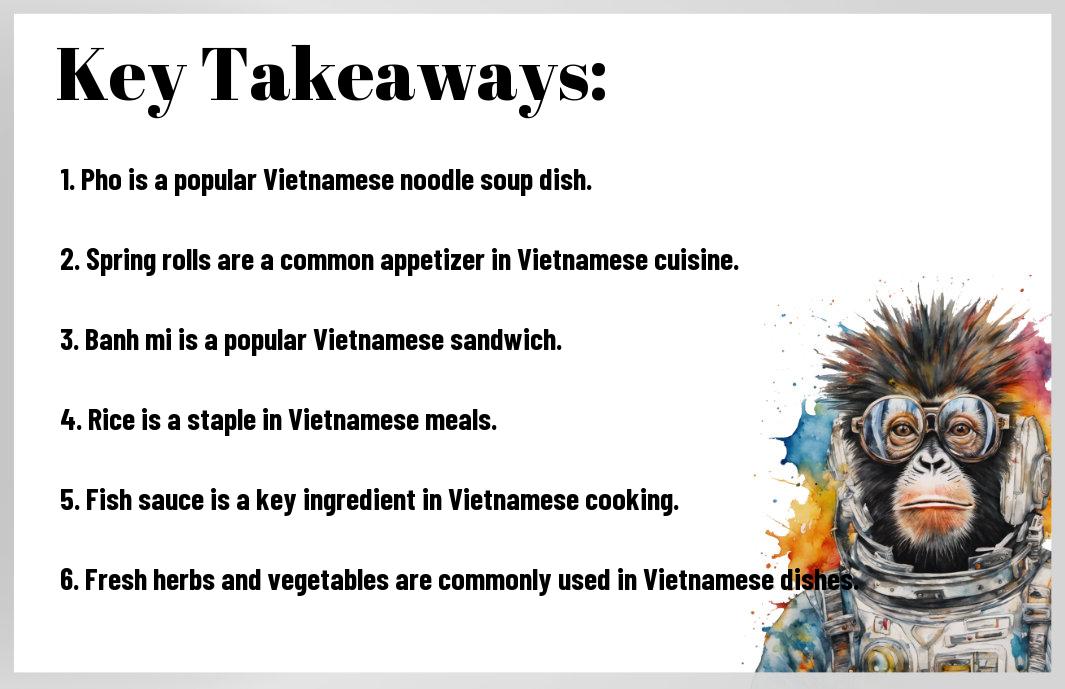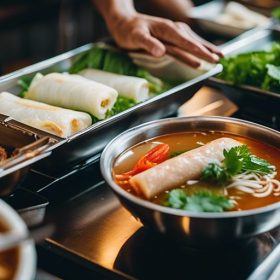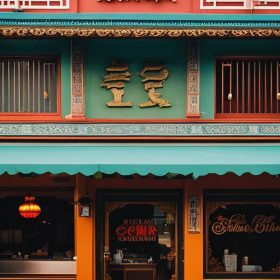Indulge in the diverse and flavorful cuisine of Vietnam with traditional dishes that will tantalize your taste buds. When you think of Vietnamese food, you may immediately picture fragrant pho or fresh spring rolls, but the country offers a wide array of culinary delights that you simply can’t miss. From the spicy and savory flavors of bun bo Hue to the sweet and tangy notes of banh xeo, Vietnam’s traditional food is a rich tapestry that reflects its history, culture, and geography. In this blog post, you’ll discover the essential dishes that you must try when exploring the vibrant food scene of Vietnam. Whether you’re planning a trip or simply want to explore new flavors, this guide will help you navigate the delicious world of Vietnamese cuisine.
Key Takeaways:
- Pho: Pho is a popular Vietnamese noodle soup dish made with broth, rice noodles, herbs, and meat, usually beef or chicken.
- Spring Rolls: Vietnamese spring rolls, or “gỏi cuốn”, are made with shrimp, herbs, rice vermicelli, and other ingredients wrapped in rice paper.
- Banh Mi: Banh Mi is a Vietnamese sandwich consisting of a baguette filled with a variety of savory ingredients such as pork, pate, vegetables, and condiments.
- Banh Xeo: Banh Xeo are savory Vietnamese crepes filled with pork, shrimp, bean sprouts, and herbs, typically served with lettuce for wrapping.
- Bun Cha: Bun Cha is a dish of grilled pork served with vermicelli noodles, herbs, and a dipping sauce, popular in the northern regions of Vietnam.
- Cơm Gà Hải Nam: Cơm Gà Hải Nam is a Hanoi specialty consisting of rice with tender, flavorful poached chicken and a side of chicken broth.
- Cafe Sua Da: Cafe Sua Da is a traditional Vietnamese iced coffee made with strong, dark roast coffee and sweetened condensed milk, served over ice.
Historical Context
One of the key factors that shaped the traditional food in Vietnam is its historical context. Vietnam’s cuisine has been influenced by various factors such as the country’s geographical location, its long history, and the cultural exchanges with neighboring countries such as China, Cambodia, and Laos.
Influences on Vietnamese Cuisine
The influences on Vietnamese cuisine are diverse and have contributed to a unique blend of flavors and cooking techniques. Chinese colonization, French colonial rule, and cultural exchange with neighboring countries have all played a significant role in shaping the traditional dishes of Vietnam. The use of ingredients such as rice, noodles, fish sauce, and fresh herbs, as well as cooking methods like stir-frying, steaming, and grilling, can be traced back to these influences.
Evolution of Traditional Vietnamese Dishes
Over the centuries, Vietnamese cuisine has evolved, adapting to changing tastes and influences. Your traditional dishes have been shaped by various historical events, such as the introduction of new ingredients and cooking techniques. Through these changes, Vietnamese cuisine has retained its unique identity, characterized by a delicate balance of flavors and emphasis on fresh ingredients.
Fundamental Ingredients and Flavors
For centuries, Vietnamese cuisine has been defined by its key ingredients and distinct flavors. From fragrant herbs and spices to fresh vegetables and meats, the traditional food of Vietnam is characterized by a balance of textures and tastes that have been passed down through generations.
Key Ingredients in Traditional Vietnamese Cooking
When it comes to traditional Vietnamese cooking, the key ingredients that you simply cannot do without are fish sauce, rice, rice noodles, fresh herbs, lemongrass, and galangal. These ingredients form the basis for many classic Vietnamese dishes, and their unique flavors and textures are central to the culinary identity of the country.
Flavor Profile: Balancing the Five Taste Elements
In traditional Vietnamese cuisine, the balance of flavors is crucial, and the cooking philosophy revolves around the concept of harmonizing five taste elements: sweet, sour, bitter, salty, and umami. These flavors are carefully balanced in every dish to create a satisfying and delicious meal that is also healthy and nourishing.
Regional Variations
Unlike many countries, Vietnam boasts a wide variety of regional cuisines, each with its own unique flavors and delicacies. The regional differences in food are primarily the result of variations in climate, terrain, and the local availability of ingredients. Let’s take a closer look at the traditional dishes from different parts of Vietnam.
Northern Vietnamese Delicacies
In the northern region of Vietnam, you will find pho, a well-known noodle soup consisting of broth, rice noodles, herbs, and meat, usually beef or chicken. Another popular dish is bun cha, which consists of grilled fatty pork served over a plate of white rice noodles and herbs. The food in this region is characterized by its mild flavors and the use of freshwater fish and prawns.
Central Vietnamese Cuisine
Central Vietnamese cuisine is known for its spicy and bold flavors. One of the most famous dishes from this region is banh xeo, a crispy and savory pancake filled with pork, shrimp, and bean sprouts. The region is also famous for its fish sauce, which is a key ingredient in many of its dishes. Additionally, mi quang, a noodle dish with a variety of flavorful toppings, is a must-try in this part of the country.
Southern Specialties
In the southern part of Vietnam, the cuisine is influenced by Khmer and Cham cultures, resulting in a unique blend of flavors. Banh mi, a Vietnamese sandwich with a French influence, is a popular street food in the south. Com tam, broken rice served with grilled pork, is another favorite dish. The use of a wide variety of herbs and vegetables gives southern Vietnamese food a fresh and vibrant taste.
Iconic Vietnamese Dishes
To truly experience the traditional food of Vietnam, you must indulge in the country’s iconic dishes. These culinary delights are beloved by locals and visitors alike, and they offer a delicious taste of the vibrant flavors that define Vietnamese cuisine.
Pho: Vietnam’s Signature Noodle Soup
If there’s one dish you cannot miss when visiting Vietnam, it’s pho. This iconic soup is a cornerstone of Vietnamese cuisine, featuring a flavorful broth, flat rice noodles, and your choice of thinly sliced beef or chicken. Accompanied by fragrant herbs, bean sprouts, and lime, pho is a sensory delight that perfectly captures the essence of Vietnamese cooking.
Banh Mi: The Fusion Sandwich
Banh mi is a delectable fusion of Vietnamese and French culinary traditions, a legacy of Vietnam’s colonial past. This iconic sandwich features a crispy baguette filled with a delectable assortment of pork, pate, pickled vegetables, and fresh herbs, creating a harmonious blend of flavors and textures that will leave you craving more.
Goi Cuon: Fresh Spring Rolls
For a refreshing and healthy Vietnamese dish, you must try goi cuon, also known as fresh spring rolls. These delectable rolls are filled with shrimp, pork, fresh herbs, and vermicelli, all wrapped in delicate rice paper. Serve them with a zesty dipping sauce, and you have a light and satisfying dish that is a staple of Vietnamese cuisine.
Bun Cha: Grilled Pork with Vermicelli
When it comes to flavorful and aromatic dishes, bun cha is a standout in Vietnamese cuisine. This dish features smoky grilled pork served with vermicelli noodles, fresh herbs, and a tangy dipping sauce. The combination of savory, sweet, and sour flavors makes bun cha a must-try culinary experience in Vietnam.
Che: Traditional Vietnamese Dessert
No exploration of Vietnamese cuisine would be complete without indulging in the country’s traditional desserts, and che is a standout in this category. Che encompasses a wide variety of sweet treats, including coconut milk, tropical fruits, and tapioca pearls, creating a range of delightful textures and flavors that are sure to satisfy your sweet tooth.
Conclusion: Exploring Vietnam’s Traditional Cuisine
From above, you have been introduced to the diverse and flavorful traditional foods of Vietnam. With its rich history and influences from various cultures, Vietnamese cuisine offers a wide range of dishes that cater to every palate. Whether it’s the iconic pho, the savory bun cha, or the refreshing goi cuon, there is something for everyone to enjoy. The vibrant flavors, fresh ingredients, and unique cooking techniques make Vietnamese cuisine a must-try for any food enthusiast. So if you ever find yourself in Vietnam, be sure to immerse yourself in the traditional food scene and indulge in the country’s delectable culinary delights.
FAQ
Q: What is the traditional food in Vietnam?
A: The traditional food in Vietnam includes a variety of dishes such as pho, spring rolls, banh mi, and bun cha.
Q: What is pho?
A: Pho is a popular Vietnamese noodle soup dish that consists of broth, rice noodles, herbs, and meat, usually beef or chicken.
Q: What are spring rolls?
A: Spring rolls are a popular appetizer in Vietnamese cuisine, consisting of fillings such as shrimp, pork, vegetables, and vermicelli noodles wrapped in rice paper and deep-fried or served fresh.
Q: What is banh mi?
A: Banh mi is a Vietnamese sandwich that typically includes a baguette filled with various ingredients such as pork, pate, pickled vegetables, and fresh herbs.
Q: What is bun cha?
A: Bun cha is a traditional Vietnamese dish featuring grilled pork served over vermicelli noodles, along with fresh herbs and a dipping sauce.
Q: Are there any vegetarian options in traditional Vietnamese cuisine?
A: Yes, there are several vegetarian options in Vietnamese cuisine, including dishes like vegetarian pho, vegetarian spring rolls, and vegetarian banh mi made with tofu or tempeh.
Q: What are some traditional Vietnamese desserts?
A: Traditional Vietnamese desserts include che, a sweet soup or pudding made from a variety of ingredients such as beans, fruits, and coconut milk, as well as sweet sticky rice dishes and fruit-based desserts.

Cuong Nguyen is a talented writer and experienced waitress at Vietnampalace.net, a renowned Vietnamese restaurant that offers an extensive menu of authentic Vietnamese cuisine. With a background in the competition of Vietnamese cuisine, Cuong brings a wealth of knowledge and expertise to the dining experience. From delicious pho dishes to fresh spring rolls, Cuong ensures that every meal is made with the freshest ingredients and authentic flavors.With exceptional service and a friendly atmosphere, Cuong takes pride in providing a memorable dining experience for every customer.
Whether you’re a vegetarian looking for options or a meat lover craving the flavors of traditional Vietnamese dishes, Cuong guarantees a delightful culinary adventure. So, visit Vietnampalace.net and let Cuong guide you through the tantalizing world of Vietnamese cuisine.



